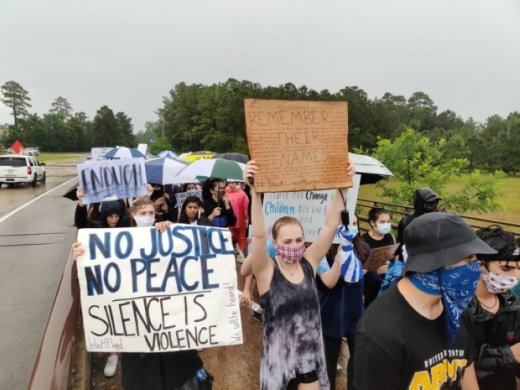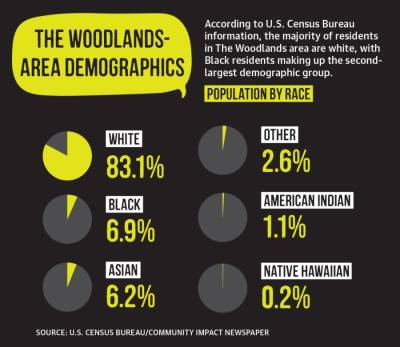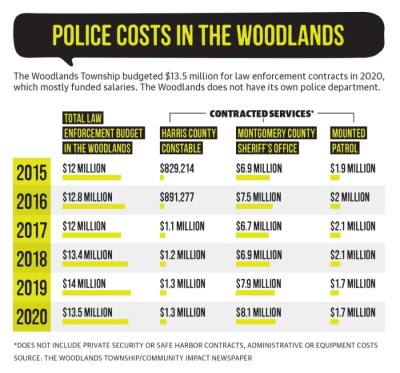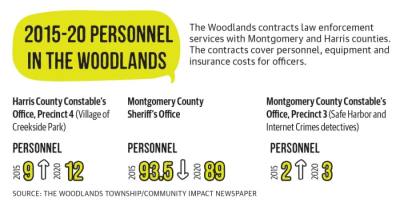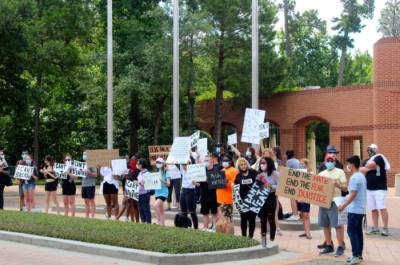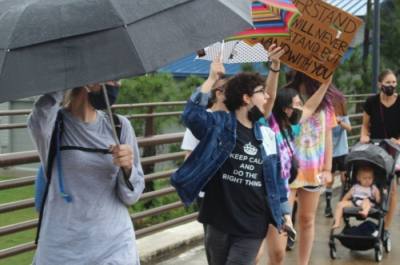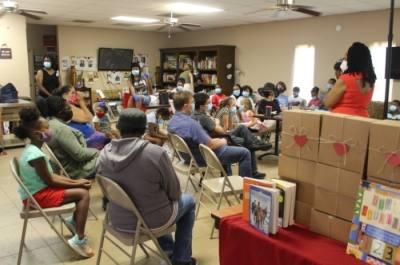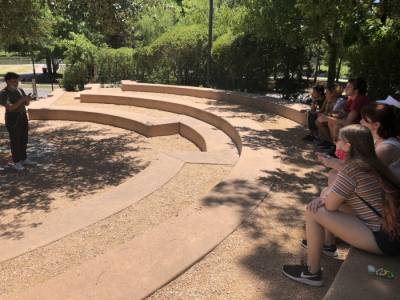Area law enforcement officials with Shenandoah, Oak Ridge North and the Montgomery County Sheriff’s Office responded by indicating a willingness to examine their use-of-force policies and other changes their departments might be able to make.
“There is a lot of work to be done to ensure we have the right language so we give our deputies the correct guidance on how to proceed in certain instances ... and also protect our citizens that we might be in an altercation with,” Montgomery County Sheriff Rand Henderson said at a June 18 The Woodlands Township meeting.
Protesters speak out
Protests throughout the month of June were largely organized by young people from area high schools, who said they gathered to speak on racial injustice.
Hailey Rodee, the founder of youth society For A New Tomorrow and a student at The Woodlands High School, organized a protest at North Shore Bridge on June 3.
“This is an issue we need to deal with as a country, and I am proud to deal with as a young person who is grateful to grow up in a nation like the United States and have it be changeable by people like myself,” Rodee said.
Rodee said she was in contact with the Montgomery County Sheriff’s Office prior to the protest, and the sheriff’s office was cordial to protestors. Despite inclement weather, protesters at the June 3 event marched on the North Shore Bridge to distance themselves from the surrounding businesses.
Demonstrators at the march said they hoped to bring attention to various issues surrounding race and inequality in The Woodlands area. Avery Robertson and Allyson Brandenburg braved pouring rain at the intersection of Lakeside Boulevard and Lake Woodlands Drive. They said they attended the event to bring attention to the voices of the area’s Black community and to unite residents.
“I came to try to make a point ... because The Woodlands is a very bubbled area, and so we don’t really stand up for anything. We all just kind of push it aside,” Robertson said. “This is a very white-ish community. We still need to be representing the Black community in this.”
Brandenburg said she was focused on accountability and solidarity. Information from the U.S. Census Bureau indicates in 2018 white residents made up around 83% of the total population in The Woodlands area. The same data states Black residents make up 6.9% of the total population of the area.
“I want to see accountability in our law enforcement; I want to see accountability in our community leaders [and] accountability in our community as a group, ... and I think we’re not very united in that way. I think there could be more unison,” she said. “We all bleed the same blood; we all come from the same place, and we’re here to support our brothers and sisters.”
A group of mostly young demonstrators also gathered in The Woodlands on June 4, holding signs and chanting at passing cars from Town Green Park on Lake Robbins Drive. Organizer Oponello Irving, a 2019 graduate of Oak Ridge High School, said the idea for the event spread across several area schools and was motivated by the racism she said she and her friends have seen.
Irving said she hopes her demonstration and others in the area can inspire students and their parents to candidly address the issue.
“There’s going to be a lot of eyes opening, and I hope that parents talk to their children and ask them, ‘Is this happening in your school? Are there people who are bullying other people based on the color of their skin?’ [I hope parents] call them out and [say], ‘I hope you’re not doing this. I hope you’re not part of the problem,’” Irving said. “I hope that parents wake up and realize that it’s not over yet.”
Law enforcement response
Law enforcement officials also spoke regarding the nationwide effects of the death of Floyd. Henderson, who addressed the topic at a June 18 meeting of The Woodlands Township board of directors, said his office is looking at banning chokeholds.
“We do not train a chokehold. There is no maneuver that is in the policy that says a chokehold is appropriate,” Henderson said.
According to Henderson, any and all uses of force within the sheriff’s office are documented, with anything deemed excessive investigated both internally and by the district attorney’s office. He said the process includes an early detection system, in which a warning is sent to a supervisor if an officer has a certain number of instances in a time frame, although Henderson did not comment on what the threshold is.
The Montgomery County Sheriff’s Office provides law enforcement to most of The Woodlands Township under contract as well as other unincorporated parts of south Montgomery County. The Harris County Precinct 4 Constable’s Office is contracted for the Village of Creekside Park in The Woodlands.
Since 2015, The Woodlands Township board of directors has increased the budget for law enforcement services and contracts from $12 million to $13.5 million. In 2015, the total made up 11% of the township’s total expenses.
In the approved $13.5 million fiscal year 2019-20 budget, $68,000 was set aside for training and conferences with Montgomery County Sheriff’s Office, a 1,600% increase from the previous year’s $4,000, according to the budget.
However, while the budget for law enforcement contracts has increased since 2015, the 2019-20 budget did decrease by around $457,000 from the previous year due to several one-time expenses the previous year, according to information in the budget.
Shenandoah interim Chief of Police Troye Dunlap said he wants to see his officers receive more training to be more confident in their ability to de-escalate a situation. For the most recent budget, the Shenandoah City Council approved a total of $50,850 for training, travel and training supplies for officers.
“We have a good budget for training; each officer is allotted a certain amount of money each year, so we allow them to go for certain training. The state also requires us to go through de-escalation training [and] citizen interaction training,” Dunlap said. “If you train officers well enough and they get their confidence, they don’t have to use that excessive force. A lot of problems officers get into is fear from not being comfortable to handle a situation. That’s what I want to work with these guys on.”
Tom Libby, the Oak Ridge North chief of police, said use of force from his department has been rare in the past several years, and the most common use of force was Taser usage when the city had more bars and clubs.
Chokeholds are also banned by the city’s police department in its use-of-force policy, which was last updated in January 2019. Libby said the policies are re-examined and updated every two years.
“There are too many unknowns that could happen from a chokehold restricting someone’s airway,” Libby said. “Your brain obviously needs oxygen. If that oxygen is restricted from the brain, it obviously could result in death or serious bodily injury. It’s just not acceptable here.”
Legislative session ahead
Across the state of Texas, protesters have been calling for police reform and limiting funding to police departments to instead focus on social services. The Texas Legislature is scheduled to meet next spring, and the issue is anticipated to be up for debate then, experts said.
Brandon Rottinghaus, a political science professor at the University of Houston, said he believes criminal justice and law enforcement reform will appear as a focus for the 2021 Texas Legislature following nationwide protests.
“I definitely think that you’re going to see [Gov. Greg Abbott] put some consensual items on the agenda to make policing more fair and just,” Rottinghaus said. “I think that’s likely to be a part, but exactly what he’ll do we don’t know. He kind of hinted at a couple things that seem like they would be acceptable, and it might not all directly relate to the policing issue; it may also be about criminal justice.”
Rottinghaus added responses from large cities and local governments across the state, including Houston, often lead to a “trickle-up effect” that adds pressure to the Texas Legislature to follow along on reform.
“If enough local governments do that then you do see a cascade of movement towards codifying what many local governments are already doing, so I suspect that you would see movement in that direction,” Rottinghaus said. “The other reason I think they are acting first is that they do not fully trust the Legislature or the powers that be in state government to do as they wish or alter what they want to do in ways they don’t want.”
Ben Thompson contributed to this report.




